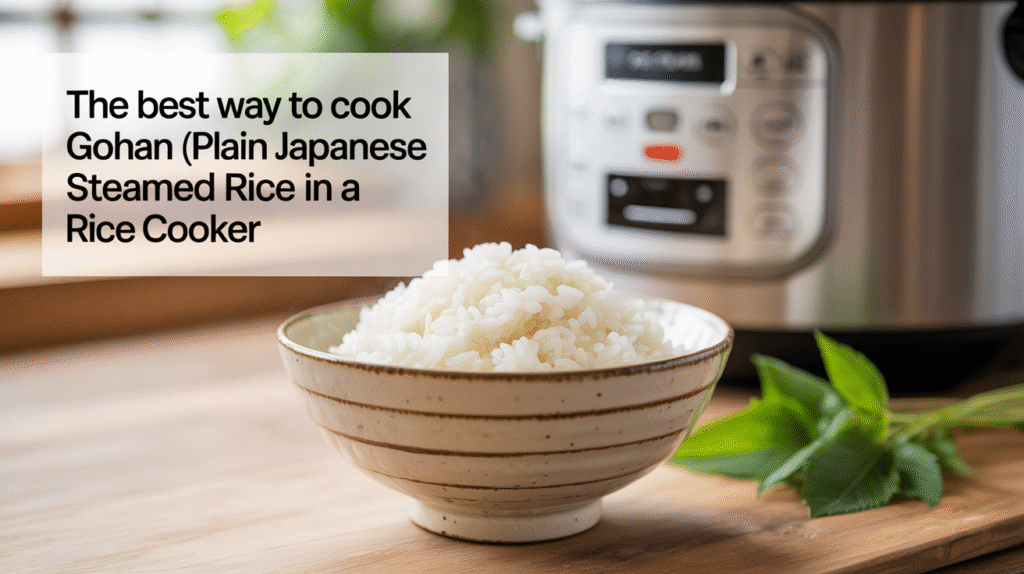The best way to cook gohan (plain Japanese steamed rice) in a rice cooker is to rinse short‑grain rice thoroughly, soak it for 20–30 minutes, and cook with the correct water ratio of 1:1.1 by weight. This method produces the glossy, slightly sticky rice that forms the backbone of Japanese meals.

What Is Gohan?
Gohan simply means “rice” in Japanese, but in practice it refers to plain steamed short‑grain rice prepared as a staple side. Unlike seasoned rice dishes, gohan is intentionally simple, highlighting the natural sweetness and stickiness of polished Japanese rice. It pairs with everything from grilled fish to miso soup and pickles.
Why Precision Matters
Because gohan is unseasoned, its appeal lies in perfect texture. Too much water makes it soggy, while too little leaves it hard. Proper rinsing, soaking, and ratios ensure balanced results.
Ingredients for Perfect Gohan
Cooking Japanese steamed rice only requires two things, but quality and accuracy matter.
Core Ingredients
- 2 cups short‑grain white rice (300 g)
- 330 ml water (for soaked rice) or 345 ml water (for no‑soak rice)
Optional Additions
While plain gohan is traditional, subtle extras can be used occasionally:
- A small piece of kombu (dried kelp) for umami infusion
- A pinch of salt if serving rice on its own
Preparing the Rice
Preparation is just as important as cooking when it comes to achieving the desired texture.
Rinsing
Rinsing removes excess starch that can make rice gummy.
- Place rice in a bowl and add cold water.
- Swirl gently, then discard the water.
- Repeat 4–5 times until the water is only slightly cloudy.
Soaking
Soaking allows rice grains to hydrate evenly before cooking.
- After rinsing, cover rice with fresh cold water.
- Let sit for 20–30 minutes.
- Drain thoroughly before adding measured cooking water.
Cooking Gohan in a Rice Cooker
The rice cooker takes over once you’ve prepped the rice properly.
- Add rinsed and soaked rice to the inner pot.
- Measure water precisely using the 1:1.1 ratio by weight or fill to the cooker’s “white rice” line.
- Start the cooker on the regular or white rice setting.
- Wait for cooking to finish—avoid opening the lid early.
- Let rice rest for 10–15 minutes after cooking for best moisture distribution.
- Fluff gently with a rice paddle, slicing through the rice instead of stirring.
Cooking Times and Yield
Cooking times depend on the rice cooker type, but the rice-to-water ratio stays consistent.
- Basic cookers: 25–30 minutes + 10 minutes resting
- Fuzzy logic or multicookers: 40–50 minutes + 10 minutes resting
- Yield: 4 servings from 2 cups uncooked rice
Tips for the Best Results
Attention to small details makes a noticeable difference in texture.
Helpful Tips
- Use a kitchen scale instead of volume cups for accuracy.
- Always rest the rice after cooking before fluffing.
- Keep rice paddle slightly damp to prevent sticking.
Common Mistakes
- Skipping the soak leads to harder rice.
- Not draining after rinsing adds unmeasured water.
- Stirring too aggressively can mash the grains.
Variations and Uses
Plain gohan can be enjoyed on its own or as the foundation for countless Japanese meals.
Everyday Pairings
- Served alongside grilled fish, miso soup, and pickles
- As the base for donburi (rice bowls topped with meat or vegetables)
Rice Variations
- Add barley (mugi gohan) for extra fibre.
- Cook with a piece of kombu for subtle depth.
Storage and Reheating
Leftover rice can be kept soft and delicious if stored properly.
Storage
- Keep warm in the cooker for up to 6 hours.
- Refrigerate portions in airtight containers for up to 3 days.
- Freeze cooled portions for up to 1 month.
Reheating
- Microwave with a splash of water, covered, for 1–2 minutes.
- Steam gently for 5–8 minutes until hot.
Nutrition Snapshot (Per 150 g Cooked Serving, Approx.)
- Calories: 240 kcal
- Carbohydrates: 54 g
- Protein: 4 g
- Fat: 0.5 g
- Fibre: 1 g
Rice Cooker Compatibility
Different machines may require small adjustments, but most handle gohan well.
- Basic models: Use standard “Cook” cycle and measure water carefully.
- Fuzzy logic cookers: Select “White Rice” for the most accurate texture.
- Pressure cookers: Reduce water slightly (closer to 1:1.05 ratio).
FAQs
Here are some questions and answers about Gohan (Plain Japanese Steamed Rice) in a Rice Cooker.
Do I need to soak the rice?
Yes, soaking for 20–30 minutes improves texture and ensures rice cooks evenly. If skipped, increase water slightly.
Can I use long‑grain rice for gohan?
No, authentic gohan uses Japanese short‑grain rice. Long‑grain varieties do not provide the right stickiness.
How do I scale the recipe?
Keep the same rice‑to‑water ratio. Just don’t exceed your cooker’s maximum capacity.
Why is my rice mushy?
Too much water or not draining rice properly after rinsing are common causes.
Can I leave rice on “Keep Warm”?
Yes, up to 6 hours, but flavour and texture are best within 2–3 hours.
Is gohan healthy?
Yes, it’s low in fat and provides steady carbohydrates. Pair with vegetables and protein for balance.